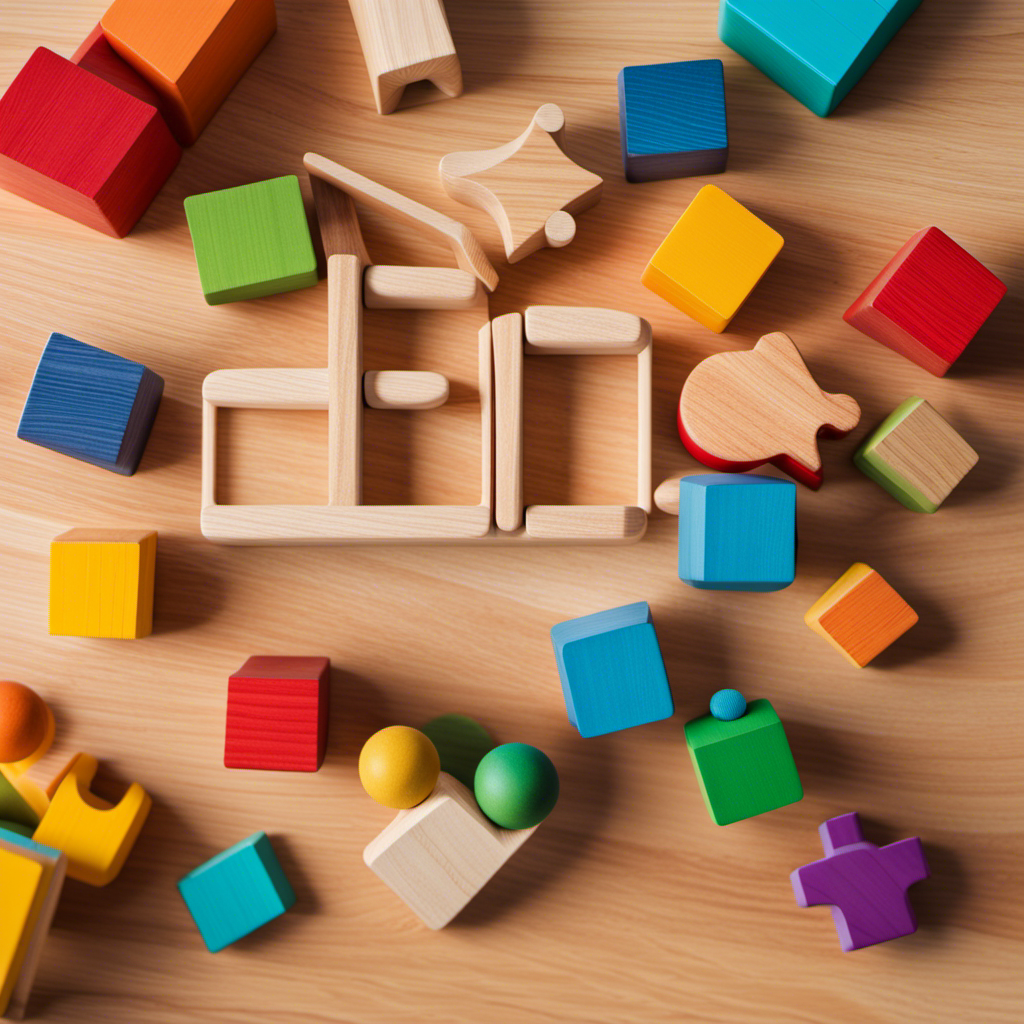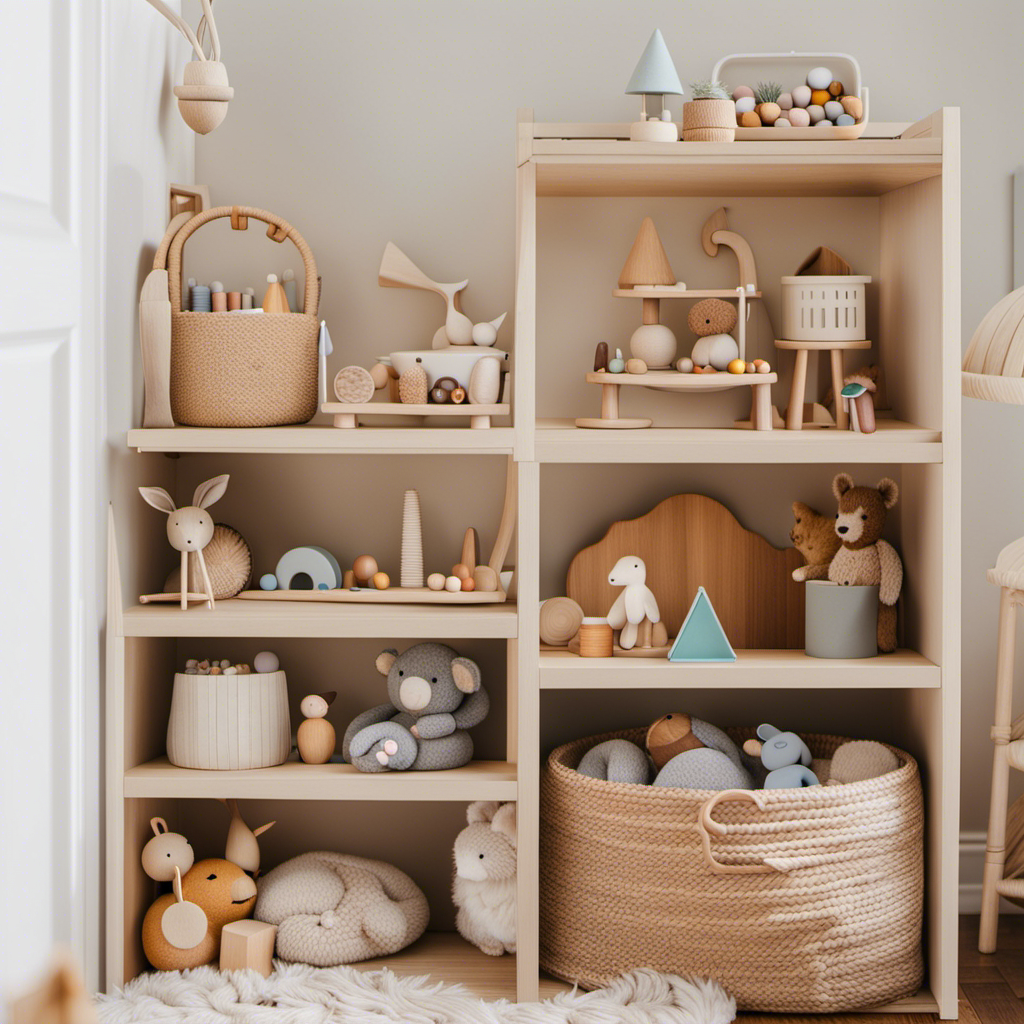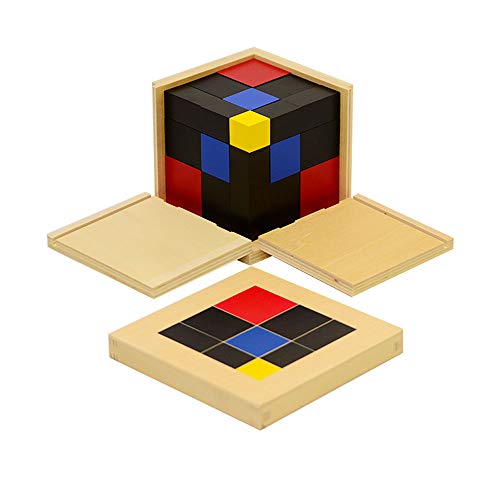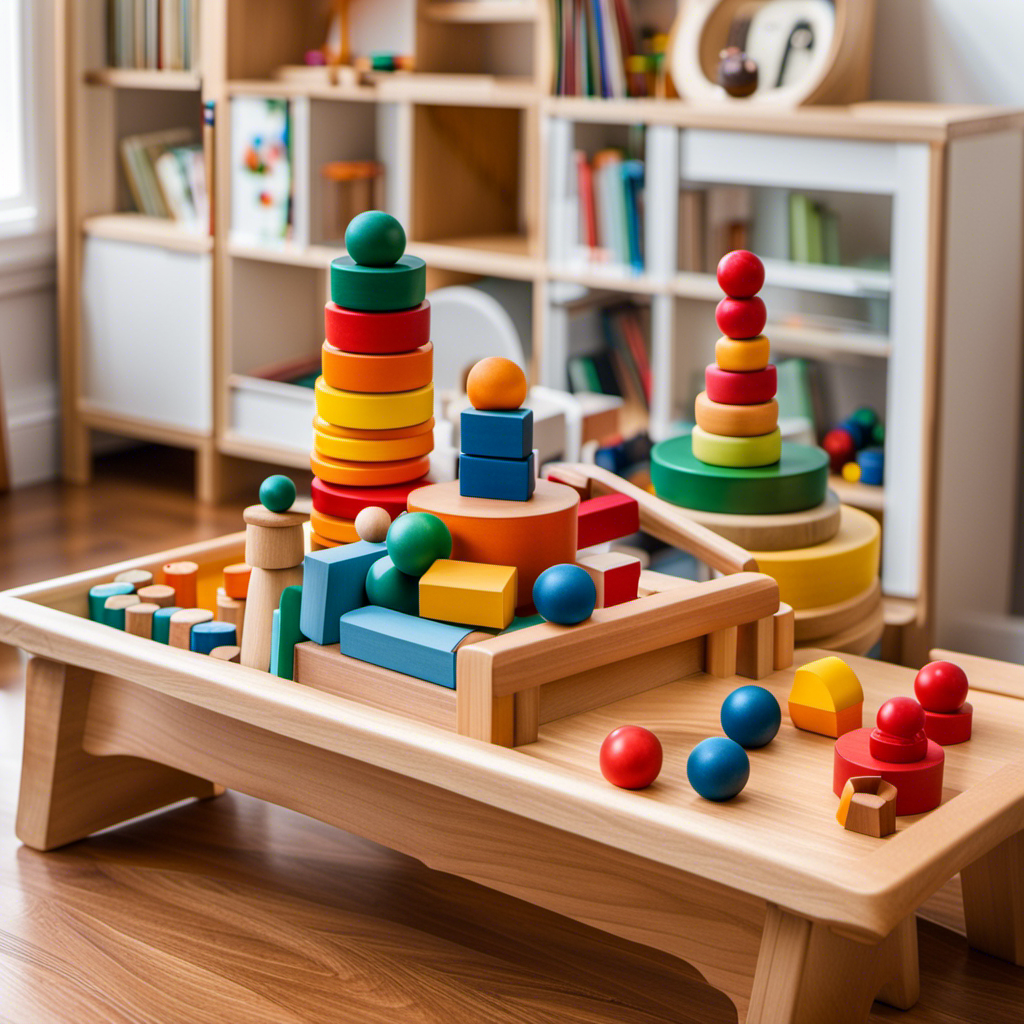I was amazed by the wonders of play, particularly when I discovered Montessori toys. It’s truly revolutionary in the way young children learn! These toys are not just ordinary playthings; they captivate a child’s interest, help develop their fine motor skills, and even aid in improving their language skills.
But what exactly are Montessori toys? In this article, I’ll delve into the origins, principles, and benefits of these toys, as well as explore how they can foster practical life skills, math and numeracy skills, and social and emotional development.
Key Takeaways
- Montessori toys were developed by Maria Montessori and are designed to support the Montessori method of education.
- These toys are simple, engaging, and promote exploration and discovery, encouraging the use of senses and fine motor skills.
- Montessori toys have a purposeful design that serves an educational purpose, focusing on the child’s interests and abilities.
- Montessori toys provide age-appropriate activities that engage children’s curiosity, promote self-confidence, and stimulate imagination and creativity.
The Origins of Montessori Toys
The Origins of Montessori Toys can be traced back to the educational philosophy of Maria Montessori. Maria Montessori was an Italian physician and educator who believed in a child-centered approach to education. She developed the Montessori method, which emphasized the importance of independence, freedom within limits, and hands-on learning.
Montessori education aims to foster a child’s natural curiosity and desire to learn. Montessori toys were created as tools to support this philosophy. They are designed to be simple, engaging, and promote exploration and discovery. These toys encourage children to use their senses and develop their fine motor skills.
The Principles Behind Montessori Toys
To understand the principles behind these educational tools, you’ll need to delve into their design and purpose. Montessori toys are rooted in the origins of Montessori philosophy, which emphasizes hands-on learning and self-directed exploration. These toys are specifically designed to foster creativity and independent thinking in children.
Here are three key principles behind Montessori toys:
-
Purposeful Design: Montessori toys are carefully crafted to serve a specific educational purpose. They are designed to engage children’s senses and promote active learning.
-
Open-Ended Play: These toys encourage open-ended play, allowing children to explore and experiment freely. They do not have a predetermined outcome, allowing children to use their imagination and creativity.
-
Child-Centered Approach: Montessori toys focus on the individual child’s interests and abilities. They promote self-discovery and personal growth, allowing children to learn at their own pace.
The Benefits of Montessori Toys
By understanding the principles behind Montessori toys, we can appreciate how these educational tools foster creativity and independent thinking in children.
Montessori toys are carefully designed to provide age-appropriate activities that engage children’s natural curiosity and promote their independence. These toys encourage children to explore and discover, allowing them to learn at their own pace and follow their individual interests.
Through hands-on experiences with Montessori toys, children develop problem-solving skills, critical thinking abilities, and a sense of autonomy. The open-ended nature of these toys allows children to use their imagination and creativity, as there are no set rules or predetermined outcomes.
Montessori toys also promote self-confidence, as children are encouraged to make choices and take ownership of their learning.
As we delve into the next section about Montessori toys for sensory development, we will see how these toys continue to support children’s growth and development.
Montessori Toys for Sensory Development
By engaging children’s senses, Montessori toys for sensory development provide a hands-on learning experience that promotes cognitive and physical growth. These toys are designed to encourage sensory exploration and tactile stimulation, allowing children to learn and explore through their senses.
Montessori toys for sensory development often incorporate different textures, shapes, and colors to stimulate the child’s senses and enhance their sensory perception. Through activities such as sorting objects by texture or identifying different scents, children are able to develop their sensory skills and improve their ability to process information from the world around them.
These toys not only provide a fun and engaging play experience, but also help children develop essential cognitive and physical skills. As children engage with these toys and explore their senses, they are preparing themselves for the next stage of development, which involves fine motor skills.
Montessori Toys for Fine Motor Skills
Engage your child’s fine motor skills and promote their hand-eye coordination through hands-on activities and play experiences. Montessori toys are designed to provide opportunities for sensory exploration and enhance fine motor coordination. These toys are carefully crafted to support a child’s development and encourage them to explore the world around them through tactile experiences.
Here is a table showcasing three popular Montessori toys that can help develop fine motor skills:
| Toy Name | Description |
|---|---|
| Shape Sorting Cube | This toy helps children develop their hand-eye coordination and problem-solving skills as they match different shapes to their corresponding holes. |
| Bead Maze | By manipulating the beads along the wires, children can improve their dexterity and finger strength. This toy also encourages concentration and focus. |
| Puzzles | Solving puzzles requires precise hand movements and coordination. It challenges children to think critically and enhances their problem-solving abilities. |
With these Montessori toys, your child can improve their fine motor skills while having fun and engaging in meaningful play. Transitioning to the next section, let’s explore Montessori toys for cognitive development.
Montessori Toys for Cognitive Development
When it comes to cognitive development in children, Montessori toys offer a multitude of benefits.
These toys are specifically designed to promote age-appropriate cognitive activities, which help children develop their problem-solving skills.
Benefits of Montessori Toys
You’ll love the benefits of Montessori toys for your child’s development. Montessori toys are specifically designed to engage children in sensory play and promote motor skill development. These toys are carefully crafted to stimulate the senses and encourage hands-on exploration, allowing children to learn and grow through play.
Here is a table that illustrates the different benefits of Montessori toys:
| Benefit | Description |
|---|---|
| Enhances creativity | Montessori toys provide open-ended play opportunities, allowing for creativity |
| Develops fine motor skills | Manipulating Montessori toys helps children improve their hand-eye coordination |
| Encourages problem-solving | Montessori toys challenge children to think critically and find solutions |
| Fosters independence | These toys promote independent play and decision-making skills |
| Enhances concentration | Montessori toys require focus and concentration, improving attention span |
With these benefits in mind, it is clear that Montessori toys offer a valuable way for children to engage in sensory play and develop their motor skills. Transitioning into the subsequent section about age-appropriate cognitive activities, we can explore further ways to support your child’s development.
Age-Appropriate Cognitive Activities
Transitioning into age-appropriate cognitive activities allows children to further develop their thinking and problem-solving skills. It is important to provide children with activities that are suitable for their age and stage of development.
Age-appropriate problem solving activities can help children refine their cognitive abilities, such as logical reasoning, critical thinking, and decision-making. These activities can include puzzles, building blocks, memory games, and problem-solving tasks.
Sensory toys are also beneficial for cognitive development as they engage multiple senses and stimulate the brain. For example, textured toys can enhance tactile perception, while musical toys can improve auditory processing skills.
Enhancing Problem-Solving Skills
In the previous section, we discussed age-appropriate cognitive activities that can support a child’s development. Now, let’s delve into how Montessori toys can enhance problem-solving skills and critical thinking techniques.
Montessori toys are designed to encourage hands-on exploration and independent thinking. They often feature puzzles, building blocks, and manipulative materials that require problem-solving strategies. These toys stimulate a child’s cognitive abilities by presenting challenges and encouraging them to find solutions.
Through engaging with Montessori toys, children learn to analyze problems, think critically, and develop creative solutions. They learn to approach challenges with patience, persistence, and adaptability. These toys provide opportunities for children to practice logical reasoning, spatial awareness, and pattern recognition.
By incorporating problem-solving skills and critical thinking techniques into play, Montessori toys foster a love of learning and independent thinking. They lay a strong foundation for future academic success.
Now, let’s explore Montessori toys specifically designed for language development.
Montessori Toys for Language Development
When it comes to language development, Montessori toys offer numerous benefits for children.
These toys are specifically designed to promote language skills development by engaging children in hands-on activities that encourage vocabulary expansion, sentence formation, and storytelling.
They are suitable for a wide range of age groups, starting from infants who are just beginning to babble all the way up to preschoolers who are ready to practice more complex language skills.
Benefits of Montessori Toys
One of the benefits of Montessori toys is that they encourage independent learning and problem-solving skills.
Here are three ways Montessori toys promote sensory play and fine motor development:
-
Hands-on Exploration: Montessori toys are designed to engage children’s senses, allowing them to explore different textures, shapes, and colors. This hands-on approach stimulates their sensory development, helping them make sense of the world around them.
-
Fine Motor Skills Development: Montessori toys often involve activities that require precise movements, such as sorting objects or manipulating small parts. These activities help children develop their fine motor skills, enhancing their hand-eye coordination and dexterity.
-
Open-Ended Play: Montessori toys encourage open-ended play, where there are no predetermined outcomes or rules. This freedom allows children to use their imagination and creativity, promoting problem-solving skills and independent thinking.
Language Skills Development
By fostering sensory play and fine motor development, Montessori toys set the stage for children to develop their language skills. Montessori toys are carefully designed to promote age-appropriate language development and to encourage children to express themselves effectively. These toys provide opportunities for children to engage in imaginative play, which helps them develop their vocabulary and storytelling abilities. For example, wooden blocks can be used to build structures, and children can describe what they are building or create stories around their creations. Additionally, Montessori toys often incorporate puzzles and matching games that require children to use language to identify and describe different objects or images. Through these activities, children not only enhance their communication skills but also learn to listen and understand others. As children play with Montessori toys, they are constantly exposed to language-rich environments that promote communication skills.
Transitioning into the subsequent section about suitable age groups, it is important to consider how Montessori toys are designed to cater to different developmental stages.
Suitable Age Groups
You can easily identify suitable age groups for these toys by considering the developmental stage of your child. Age appropriate toys play a crucial role in the development of children. They not only entertain but also stimulate their cognitive, physical, and social-emotional growth. Here are some key points to consider when choosing age appropriate toys:
-
Infants (0-12 months):
-
Toys with contrasting colors and different textures to stimulate their senses.
-
Rattles and teething toys to encourage fine motor skills.
-
Soft toys for cuddling and comfort.
-
Toddlers (1-3 years):
-
Building blocks and shape sorters to enhance problem-solving skills.
-
Puzzles and stacking toys to promote hand-eye coordination.
-
Pretend play toys, like kitchen sets or tool kits, to encourage imaginative play.
-
Preschoolers (3-5 years):
-
Art supplies, such as crayons and clay, to foster creativity.
-
Board games and memory matching games to develop social skills.
-
Musical instruments to promote rhythm and self-expression.
Understanding the suitable age groups for these toys is essential for providing a stimulating and engaging play environment for your child.
Transitioning into the subsequent section about ‘montessori toys for practical life skills,’ we can explore how these toys can further enhance their development.
Montessori Toys for Practical Life Skills
To develop practical life skills, try incorporating Montessori toys into your child’s playtime. Montessori toys are designed to promote independence and help children learn essential skills that they can apply in their daily lives. These toys are age appropriate and provide opportunities for children to engage in activities such as pouring, sorting, and buttoning, which develop their fine motor skills and hand-eye coordination.
By using Montessori toys, children learn to take care of themselves and their environment, fostering a sense of responsibility and independence. These toys also encourage problem-solving and decision-making skills, as children navigate through different tasks and challenges. By introducing Montessori toys into your child’s playtime, you are providing them with opportunities to develop practical life skills that will benefit them in the long run.
Transition: As children develop their practical life skills, they can also enhance their math and numeracy skills through Montessori toys.
Montessori Toys for Math and Numeracy Skills
Transitioning from practical life skills, children can also improve their math and numeracy abilities with the help of Montessori toys. These toys are specifically designed to introduce and reinforce mathematical concepts in a hands-on and engaging way.
Montessori toys for math and numeracy focus on developing counting skills, number recognition, and basic operations such as addition and subtraction. For example, toys like number puzzles, counting rods, and bead chains provide opportunities for children to practice counting and understand numerical relationships.
Through these toys, children can develop a solid foundation in mathematical concepts while having fun and exploring their curiosity. As they engage with these toys and manipulate the materials, they naturally begin to understand abstract mathematical ideas. This lays a strong foundation for future math learning.
Moving on to Montessori toys for social and emotional development…
Montessori Toys for Social and Emotional Development
As a child development expert, I understand the importance of playtime in a child’s social and emotional development. Playtime not only provides opportunities for children to have fun and relax, but it also allows them to explore their emotions, develop social skills, and enhance their empathy.
One way to promote empathy through play is by using toys that encourage role-playing and storytelling, allowing children to step into the shoes of different characters and understand their feelings and perspectives.
Importance of Playtime
Playtime is crucial for children’s development as it allows them to explore and learn in a fun and engaging way. Unstructured play, where children have the freedom to create their own games and activities, is particularly important. It fosters creativity and imagination, as children are encouraged to think outside the box and come up with their own ideas.
Playtime also provides an opportunity for children to develop problem-solving skills, as they navigate through different scenarios and find solutions. Additionally, it helps children build social skills through interaction with others, teaching them important lessons in empathy, cooperation, and communication.
By engaging in play, children are able to develop a wide range of cognitive, physical, and emotional skills that will benefit them throughout their lives.
Transitioning into the next section, toys can further enhance empathy by encouraging children to understand and connect with others on a deeper level.
Enhancing Empathy Through Toys
When you engage with different types of toys, you can develop a stronger sense of empathy by putting yourself in the shoes of others and understanding their experiences. Toys play a crucial role in developing emotional intelligence and promoting social interaction. They provide opportunities for children to explore different perspectives, emotions, and social situations. For example, playing with dolls allows children to imagine themselves in different roles and act out scenarios, fostering empathy and understanding. Additionally, board games and cooperative toys encourage collaboration, communication, and problem-solving skills, helping children navigate social interactions effectively. By incorporating toys that represent diverse cultures, abilities, and experiences, children can learn to appreciate and celebrate differences, ultimately leading to a more empathetic and inclusive society.
| Role-playing toys | Board games | Cooperative toys |
|---|---|---|
| Dolls | Monopoly | Building blocks |
| Play kitchen | Scrabble | Puzzle games |
| Costumes | Chess | Team sports games |
Table: Examples of toys that promote empathy, social interaction, and emotional intelligence.
Frequently Asked Questions
How Do Montessori Toys Differ From Traditional Toys?
When comparing Montessori toys to traditional toys, there are a few key differences to consider.
Montessori toys are designed to promote hands-on learning, creativity, and independence. They are typically made from natural materials and focus on real-life experiences.
In contrast, traditional toys often prioritize entertainment value and may include electronic components.
The benefits of Montessori toys include fostering problem-solving skills, concentration, and fine motor development. By encouraging active engagement, Montessori toys provide a more holistic and educational play experience for children.
At What Age Should Children Start Playing With Montessori Toys?
When it comes to introducing Montessori toys to children, it’s important to consider their developmental readiness. While there isn’t a specific age that applies to all children, it’s generally recommended to start around 6 months when they begin exploring objects and developing fine motor skills.
Introducing Montessori toys at a young age can have numerous benefits. It can foster independence, promote concentration, and stimulate cognitive and physical development. By providing toys that are designed to encourage hands-on exploration and problem-solving, children can develop important skills and abilities.
It’s never too early to start setting the stage for lifelong learning. By incorporating Montessori principles and toys into a child’s playtime, parents and caregivers can help lay a strong foundation for their future education. This approach encourages a love of learning and supports the development of essential skills that will benefit them throughout their lives.
Are Montessori Toys Expensive?
Yes, Montessori toys can be expensive, but there are cost-effective alternatives available. Many parents choose to make their own DIY Montessori toys using everyday household items. This not only saves money, but also allows for creativity and customization.
Additionally, there are affordable Montessori toy options available online and in stores. It’s important to remember that the value of Montessori toys lies in their educational benefits, rather than the price tag.
Can Montessori Toys Be Used in a Classroom Setting?
Using Montessori toys for homeschooling or in a classroom setting can have numerous benefits. These toys are specifically designed to enhance learning and promote independent thinking. They encourage hands-on exploration and problem-solving skills.
Montessori toys also foster creativity and imagination, allowing children to engage in open-ended play. In a classroom, these toys can help create a stimulating and interactive learning environment. They promote collaboration and social skills, while simultaneously supporting individual growth and development.
Overall, incorporating Montessori toys into education can greatly enhance the learning experience.
Where Can I Purchase Montessori Toys?
I love shopping for Montessori toys! It’s like diving into a treasure trove of educational gems.
When it comes to finding Montessori toys, there are plenty of options. You can explore online marketplaces like Amazon or educational toy stores like Lakeshore Learning. Some popular Montessori toy brands include Melissa & Doug, Hape, and PlanToys.
Remember to choose toys that are age-appropriate for your child’s developmental stage to ensure the best learning experience.
Conclusion
After delving into the world of Montessori toys, I’m amazed at the wealth of benefits they offer.
These toys not only stimulate the senses but also foster the development of fine motor skills, language abilities, practical life skills, and math and numeracy skills.
They even play a vital role in nurturing social and emotional growth.
Just like a gentle breeze whispering through a blossoming garden, Montessori toys create an environment where children can flourish and bloom, unlocking their true potential.
Tina is the heart and soul behind Toddler Ride On Toys. With a passion for early childhood education and a deep understanding of child development, Tina ensures that every piece of content on our website reflects our commitment to playful learning. Her expertise in Montessori, Preschool, STEM, and Waldorf education philosophies helps shape our website into a valuable resource for parents, caregivers, and educators.










